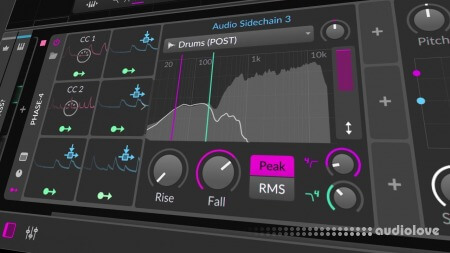Polarity Music Audio Reactive Modulations

I crafted a tutorial on how to use an envelope follower in Bitwig Studio to modulate the frequencies of a filter on a bass track using the amplitude of drums on a drum bus. This approach aims to create dynamic interaction between the bass and drum tracks, preventing the bass from sounding too static and lifeless. Here's a summary of the key points:
Introduction to the Concept: The goal is to use Bitwig's modulation capabilities to create a more lively mix by having the bass frequency respond to the drum's amplitude, particularly the kick and snare.
Setting Up the Modulators:I introduced a Side Chain Audio Side Chain Modulator to capture the drum signal and use it to modulate parameters on the bass track.
A bandpass filter isolated specific drum frequencies, like the kick, for targeted modulation.
I also demonstrated using an audio rate modulator, which acts like an envelope follower, providing fast modulations based on the drum's waveform.
Application on Synths and Effects:The techniques were applied to a Phase 4 synthesizer and various effects, including filters and EQ+, to modulate parameters like filter cutoffs and EQ bands based on the drum's amplitude.
This included using the modulators to dynamically adjust the filter's cutoff frequency and to create ducking effects, where the volume of the synth or bass is reduced momentarily when the kick hits.
Advanced Techniques:I explored the use of Bitwig's FX Grid to create more complex modulation chains, including delayed responses to drum hits for a more groovy feel.
Delays and attenuators within the FX Grid allowed for intricate timing adjustments, ensuring modulations didn't occur instantly but were rhythmically aligned with the music.
Modulation via MIDI CC:I showed how to extend modulation capabilities outside of Bitwig's grid environment by converting audio signals to MIDI CC messages. This allows for broader application of these dynamic modulation techniques across various instruments and effects.
Creative Possibilities:The tutorial highlighted Bitwig Studio's flexibility, showcasing how these techniques can be applied not only to bass and drums but also to pads and other elements, enhancing cohesion and interaction within the mix.
Conclusion: I emphasized the vast potential of Bitwig Studio for creating dynamic and responsive music productions. By using modulation sources like drum amplitude to control various parameters, music producers can achieve a more engaging and organic sound.
This tutorial showcases Bitwig Studio's powerful modulation capabilities, particularly for creating a dynamic relationship between drums and bass, ultimately bringing more life and movement to music productions.
Home page
DOWNLOAD
